 While decrease in physical strength and speed are seen in the elderly, brain changes are less clear. There is a common belief that the elderly gradually loose some mental capacities. But, is this true? Recent research shows the surprising fact that elderly brains are often better than younger brains for many tasks. This is logical if we consider the growth of wisdom in the elderly. But, what is it about the brain that correlates with wisdom?
While decrease in physical strength and speed are seen in the elderly, brain changes are less clear. There is a common belief that the elderly gradually loose some mental capacities. But, is this true? Recent research shows the surprising fact that elderly brains are often better than younger brains for many tasks. This is logical if we consider the growth of wisdom in the elderly. But, what is it about the brain that correlates with wisdom?
 It is now understood that the brain is extremely active with neuroplasticity creating new cells for learning and constantly building and pruning connections. It was thought that neuroplasticity is greatest in the child, less in the adult, and very much less in the elderly.
It is now understood that the brain is extremely active with neuroplasticity creating new cells for learning and constantly building and pruning connections. It was thought that neuroplasticity is greatest in the child, less in the adult, and very much less in the elderly.
In fact, new research shows that neuroplasticity continues throughout all ages, but the processes in the elderly are different, using different regions and unusual mechanisms. Late in life, unique new circuits and ways of thinking are produced using more connections to and from the advanced frontal lobes. In addition, both sides of the brain are utilized where only one is used in the younger adult. It was known that frontal lobes develop throughout childhood and are still developing for young adults. But, only recently, has it been shown that the elderly continue to use neuroplasticity in the frontal lobes with new ways of thinking through new brain structures. Does cognitive ability improve in old age?
 The brain changes that occur in aging are different in each individual—there is really no set pattern. In fact, the course of the changes is altered by a lifetime of neuroplasticity and conscious activity. Clearly, there are diseases that hurt the brain—diseases of the blood vessels, unstable metabolism, misfolded brain proteins and chronic extreme stress.
The brain changes that occur in aging are different in each individual—there is really no set pattern. In fact, the course of the changes is altered by a lifetime of neuroplasticity and conscious activity. Clearly, there are diseases that hurt the brain—diseases of the blood vessels, unstable metabolism, misfolded brain proteins and chronic extreme stress.
There are, also, lifestyle changes and behaviors that can help—staying cognitively challenged, eating good food, sleeping enough and exercing. Please see the post Five Secrets of Brain Health for some of the positive activities that can help the brain last longer and stay healthier.
In all parts of the world, the number of elderly is increasing. Medical progress and increases in living standards, such as nutrition and education, are keeping people alive longer. As the population ages, the problems with cognitive loss in the elderly brain are arising later and later. The so-called mental decline of old age is coming later.
There is now evidence that decrease or increase of capacities are quite variable in individuals and can be affected by individual behavior and neuroplasticity. There are many factors that affect the course of an individual’s cognition in old age. These include genetics, epigenetics, neuroplasticity, environment, behavior, education, vascular and metabolic disease, inflammation, stress and diseases of mis folded proteins (Alzheimer, etc).
What Brain Deficits Do Occur in Old Age
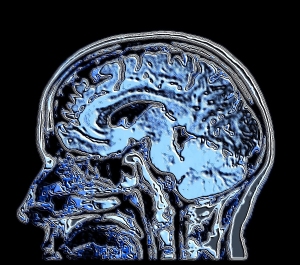 Studies attempting to find the peak years of cognitive abilities show that chess championships are around 36 or younger and correspondence chess, where moves can be made over a three-day period, are around 46. Mathematicians tend to make their major discoveries early. But, many other intellectual pursuits and perception of complex patterns are better in the older brain.
Studies attempting to find the peak years of cognitive abilities show that chess championships are around 36 or younger and correspondence chess, where moves can be made over a three-day period, are around 46. Mathematicians tend to make their major discoveries early. But, many other intellectual pursuits and perception of complex patterns are better in the older brain.
The older brain is statistically smaller in size and weight with larger ventricles and sulci. The decrease consists of both grey matter (cell bodies) and white matter (axon fibers). Some regions have less myelin and some dendrite arbors are smaller. There are less synapses. The decreases appear more in certain regions. For example, the visual cortex does not change. Hippocampus’ have little change (but research is inconsistent). Regions that have large multi sensory input have more decreases.
On MRI, hyper densities in white matter show statistical increases, along with inflammation. This refers to microscopic blood vessel damage and loss of myelin. There is a question of whether specific age related changes occur in the dendrite spines, but research has only been in animals.
 When brains do show cognitive declines there are some age related differences in the biochemistry of the brain. Neurotransmitters, for example, can be different in late age for those with cognitive declines. Dopamine neurons are less modulated in transmission from the midbrain to the cortex. But, its effect is not clearly understood.
When brains do show cognitive declines there are some age related differences in the biochemistry of the brain. Neurotransmitters, for example, can be different in late age for those with cognitive declines. Dopamine neurons are less modulated in transmission from the midbrain to the cortex. But, its effect is not clearly understood.
Episodic memory is correlated with gene variants of BDNF (brain derived neurotrophic factor – a critical molecule for brain health), dopamine receptors and transporters, and glutamate receptor genes. These variations have small effects.
But, in fact, there are too many genetic variables that impact on length of life to understand which are relevant in determining individual variations or decline with aging. Different variations might explain these individual cognitive abilities in old age.
Greater Variation Among Individuals
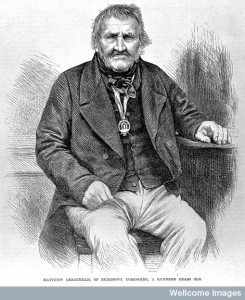 The greater variation in cognitive ability is not with age, but between elderly individuals. Comparing individuals, variations in size are most remarkable in the hippocampus, lateral pre frontal cortex, and white matter in the pre frontal region—the regions most related to advanced cognitive processes.
The greater variation in cognitive ability is not with age, but between elderly individuals. Comparing individuals, variations in size are most remarkable in the hippocampus, lateral pre frontal cortex, and white matter in the pre frontal region—the regions most related to advanced cognitive processes.
Previous research on aging focused on decreased vision, hearing and forgetfulness and decreased ability to filter out irrelevant information. But, these decreases vary tremendously among individuals.
Brain shrinking correlates with metabolic disease and hypertension. Risky behavior is correlated with declines, such as smoking. Those with higher mental abilities during childhood tend to maintain this advantage.
 Cognitive loss can occur even within the so-called normal range with sub-clinical metabolic disease. Even if dementia is not considered, in the generally healthy group, there is tremendous variation. The shrinkage, if it occurs, is in all of the three areas at once, not selectively (hippocampus, lateral pre frontal cortex, and white matter in the pre frontal region).
Cognitive loss can occur even within the so-called normal range with sub-clinical metabolic disease. Even if dementia is not considered, in the generally healthy group, there is tremendous variation. The shrinkage, if it occurs, is in all of the three areas at once, not selectively (hippocampus, lateral pre frontal cortex, and white matter in the pre frontal region).
Changes that do occur are in fluid intelligence, speed of perception, vocabulary and memory. The knowledge gained in the past, such as language and vocabulary, are called crystallized abilities. Thinking, learning and decision-making are called fluid abilities.
Theories of the mechanism of individual declines are not proven, but include:
- The dopamine changes already noted in the striatum and cortex
- Alterations in connections between these regions by changes in anatomy
- Alterations in connections through white matter
- Less activation of neurons
- Changes in synchronized oscillations
Neuroplasticity In Old Age
 Neuroplasticity continues into very late age. As the previous post on brain health noted, neuroplasticity is highly related to mental activity and physical exercise. Exercise, also lowers the vascular and metabolic risk. Please see posts, Neuroplasticity Primer, and Vast Array of Different Neuroplasticity Mechanisms for summaries of neuroplasticity. Factors that are important for neuroplasticity include genes, lifestyle (see Five Secrets of Brain Health), sleep, exercise, conscious activities, cognitive training, and strategy training.
Neuroplasticity continues into very late age. As the previous post on brain health noted, neuroplasticity is highly related to mental activity and physical exercise. Exercise, also lowers the vascular and metabolic risk. Please see posts, Neuroplasticity Primer, and Vast Array of Different Neuroplasticity Mechanisms for summaries of neuroplasticity. Factors that are important for neuroplasticity include genes, lifestyle (see Five Secrets of Brain Health), sleep, exercise, conscious activities, cognitive training, and strategy training.
Brain flexibility is defined as changing behavior without anatomical brain changes (without neuroplasticity). Elderly people have already developed abilities for many different types of behavior in their life. The use of these different behaviors is available to them, even if they haven’t been tapped for years, without much energy demand in the brain.
Brain plasticity refers to alterations in brain connections and structures with learning and behavior. The changes of neuroplasticity consume more energy. Children and young adults use the neuroplasticity to develop the expanded types of behavior that elderly have already accomplished.
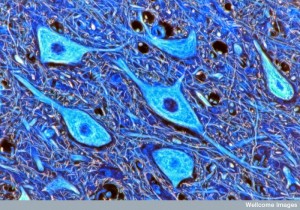 New imaging research is now emphasizing the great plasticity of the elderly brain. It shows that elderly brains can use new connections of wide ranging regions in unique ways to do cognitive tasks in different ways than young brains.
New imaging research is now emphasizing the great plasticity of the elderly brain. It shows that elderly brains can use new connections of wide ranging regions in unique ways to do cognitive tasks in different ways than young brains.
In the young, left frontal cortex specializes in verbal information for active memory. In the older brain, this region can used for many different purposes and they, also, use the right frontal, that usually is for visual information (for example, using a map). While it is not possible to know this by just looking at behavior, neuroscience shows very varied patterns. Neuroplasticity consists of using the brain in constantly new ways. The creation of new neurons continues in old age with learning and this is one way this can occur. But, there are, also, many new connections and synapses supporting different ways of using the brain.
Studies of electrical stimulation are just beginning to show how some regions can be altered and improved. The results appear to be very specific to individuals. For example, stimulation of the left hemisphere helps working memory in those elderly who are more educated. It helps generating words. Results have been mixed, possibly because they only can affect the superficial brain layers, not the deep regions.
 There is, also, evidence for more neuroplasticity in regions related to social and emotional activities. There is little evidence of atrophy in the amygdala. The elderly use more of the frontal region (perhaps understanding social patterns with experience and wisdom) in emotion as they do with cognition. In social activity, also, there is some evidence of a changed pattern of brain usage.
There is, also, evidence for more neuroplasticity in regions related to social and emotional activities. There is little evidence of atrophy in the amygdala. The elderly use more of the frontal region (perhaps understanding social patterns with experience and wisdom) in emotion as they do with cognition. In social activity, also, there is some evidence of a changed pattern of brain usage.
Older people prefer positive to negative information, which alters how they use the frontal lobes. Social tasks are able to be more flexible in the elderly. Those who are very conscientious have more positive outcomes and have less shrinkage of the brain. Those who have better social networks, more satisfying jobs, more activity in hobbies and more education have more youthful brains. Because of dopamine changes, losses can tax the striatal and reward centers more than successes. Those who can benefit more from rewards, or positive experiences, are correlated with increase connections of thalamus and the striatum.
 One study shows that dopamine, also, functions differently in the young and the old in stimulating the pre frontal cortex, the seat of decision-making.
One study shows that dopamine, also, functions differently in the young and the old in stimulating the pre frontal cortex, the seat of decision-making.
There is some evidence that ability to maintain reminders and hints by oneself decreases. The change is in the pre frontal and posterior brain. This change can affect remembering. However, when the hints come from the environment, the difference in memory vanishes. In tasks that rely on external information, elderly do better. They are better in such perception and learning. While reliance on external cues becomes a pattern in the elderly, this doesn’t mean they are impaired when they don’t have these cues. Using the environment saves brain energy as a strategy in old age.
 Shopping has been noted to be one of the more complex cognitive activities. For this reason, even advanced robots have not been able to perform this function. The comparisons of different items involve an extremely large amount of factors of size, shape, amounts and risk and reward. Many items have to be kept in memory at the same time.
Shopping has been noted to be one of the more complex cognitive activities. For this reason, even advanced robots have not been able to perform this function. The comparisons of different items involve an extremely large amount of factors of size, shape, amounts and risk and reward. Many items have to be kept in memory at the same time.
Even though some aspects of their memory might not be as good (such as naming) they are able to recruit other parts of the brain, not usually used in these tasks, to help in this complex process. In particular they recruit the ventro medial prefrontal cortex as the demands grew greater. In fact, the elderly are better at shopping with better results in the research compared with younger adults.
Another finding is that neuroplasticity occurs in a different way in the elderly. In one study related to a new visual skill, the elderly altered the axons and myelin in different ways than the younger adults.
Language, Neuroplasticity and Aging
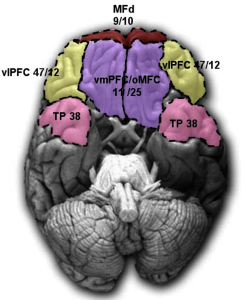 Language is one of the critical functions throughout life and involves a large number of brain regions. While there are slight alterations in word finding, basic language ability remains very stable throughout aging. There are alterations in the networks and connections to responses related to language, but not the basic language abilities. Word knowledge actually gets better in old age.
Language is one of the critical functions throughout life and involves a large number of brain regions. While there are slight alterations in word finding, basic language ability remains very stable throughout aging. There are alterations in the networks and connections to responses related to language, but not the basic language abilities. Word knowledge actually gets better in old age.
Language uses so many different brain regions and connections, it is odd in some ways that the elderly are so good at it. Syntax abilities are the same in the elderly.
The one area that appears to decrease is access of phonemes (simple sounds related to words). This is why it is hard for elderly to learn a new language. It is not clear if this is related to decrease of specific abilities, re organization of networks, or an alteration in the relation to other systems?
Elderly who maintain full cognitive ability have increased new connectivity with the prefrontal cortex and many other regions. Elderly use both sides of the brain whereas younger adults use only one side. The frontal lobes that have evolved last become the strongest part of new abilities and compensations. Young have the very integrated local networks and less connectivity between modules. Aging have increased connectivity between the modules and some decrease in local connectivity.
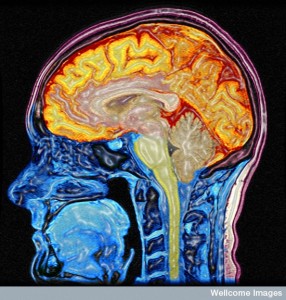 Language involves both sides of frontal, temporal and parietal cortex, which is then modulated by regions of sound, grammar and meaning. The frontal lobes are involved in competition among ideas, integration of all the other regions.
Language involves both sides of frontal, temporal and parietal cortex, which is then modulated by regions of sound, grammar and meaning. The frontal lobes are involved in competition among ideas, integration of all the other regions.
Comprehension of spoken language involves many different brain regions related to sounds, words, and meaning that respond very quickly. The brain processes this information in 200 milliseconds and keeps up with meaning. Elderly are able to keep up with this very rapid complex process. It includes understanding grammar, sounds, and meanings. Hearing can affect this ability in noisy rooms.
Producing language involves intension, creating meaning, syntax, grammar, words and sounds. When naming a flashing picture, grammar regions are at 200ms, sounds at 300ms and speech at 500ms. For some elderly, there is a decline in this process, which could be related to word finding. Many have simpler speech with more pauses. This word finding decline appears as the experience of having the meaning and word on the “tip of the tongue”. Although many elderly worry about this being a sign of dementia, in fact, research shows it is word finding.
The left frontal temporal network for grammar does decline with age. This stimulates more connectivity between other regions to compensate
Decreased Word Production
 Finding the meaning of a word and the relation of the sound to the word uses many different brain regions. Both young and old have word finding difficulties at times. Older people have less ability to rapidly relate the sound and the word, which slows speech, but not meaning. It is not clear why this access is less in the elderly.
Finding the meaning of a word and the relation of the sound to the word uses many different brain regions. Both young and old have word finding difficulties at times. Older people have less ability to rapidly relate the sound and the word, which slows speech, but not meaning. It is not clear why this access is less in the elderly.
There are different brain reactions to not being able to find a word in the young and the elderly. In the young, regions of control are triggered and they more frequently have the first sound of a word that is on the “tip of the tongue”. In the elderly, these same regions of control are used much more widely for all speech, not only for the ones where there is a word lacking. When elderly don’t know the word, they use less control regions than the young. Both recruit help but differently.
Improving Cognitive abilities
 Training the brain can improve different capacities. One large study showed increased white matter in the corpus callosum (connection of right and left brain) and less shrinking of cerebellum in young and old with training. Four months of training in spatial navigation in young and old made the hippocampus stronger and less likely to shrink.
Training the brain can improve different capacities. One large study showed increased white matter in the corpus callosum (connection of right and left brain) and less shrinking of cerebellum in young and old with training. Four months of training in spatial navigation in young and old made the hippocampus stronger and less likely to shrink.
In general, the broad claims made by online brain exercise companies are not valid or proven. There is evidence that training a specific task will increase ability to do that task. But, there is little proven carryover to other tasks.
 In fact, neuroplasticity research shows that the more brain connections that are used at once increase the growth of new connections. Therefore activities that include movement, multiple senses, meaning and conscious activity such as meditation have the most impact. (see post Neuroplasticity Primer.) Music and art activities have shown some carryover into improvement in other areas (this is called metaplasticity—see post on Music and Neuroplasticity).
In fact, neuroplasticity research shows that the more brain connections that are used at once increase the growth of new connections. Therefore activities that include movement, multiple senses, meaning and conscious activity such as meditation have the most impact. (see post Neuroplasticity Primer.) Music and art activities have shown some carryover into improvement in other areas (this is called metaplasticity—see post on Music and Neuroplasticity).
Mental activity that is meaningful has the most impact for learning and neuroplasticity. Also, meaningful activity that helps the community has been shown to positively stimulate the immune system (see post).
Does Cognitive Ability Improve In Old Age
Some consider aging to be just an attitude. With increasing evidence of the critical impact of lifestyle on cognitive ability, this may be more correct than previously thought.
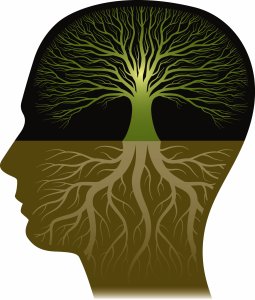 The elderly show increased abilities to use the frontal brain regions, the seat of the most advanced cognitive processes, in new connections during various tasks. They have some decrease in abilities, but they are few. The compensations use new brain regions and make overall function superior.
The elderly show increased abilities to use the frontal brain regions, the seat of the most advanced cognitive processes, in new connections during various tasks. They have some decrease in abilities, but they are few. The compensations use new brain regions and make overall function superior.
One decrease is in access to phonemes for language and decrease in some word finding. But, compensations use many other brain regions that form new types of connections making their language capacities, in fact, more advanced. Notably, elderly use more new connections with the frontal regions and use both sides of the brain where the younger adult uses only one. They use many different neuroplasticity techniques, some unique in individuals.
Elders have superior social and emotional perception, control and understanding. They understand patterns better.
Some refer to the ability to understand many different circumstances with appropriate responses as wisdom. This, also, includes the ability of the elderly to understand many different patterns that appear in their sensory input—circumstances, ideas, and experiences. The elderly’s superior ability to size up situations are coupled with better social and emotional regulation–hallmarks of wisdom.
The reason we turn to the elderly for their experience and knowledge is because, in fact, many have developed superior brains.